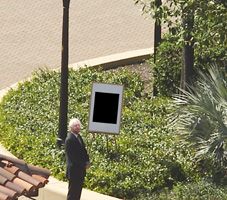Escher's Printgallery in Stanford
based on article Henry Segerman
http://www.segerman.org/printgallery/
 Sometime in 2002, Paul-Olivier Dehaye
and Henry Segerman went to a lecture given by Hendrik
Lenstra (Universiteit Leiden and previously UC Berkeley) about his
investigations into Escher's Printgallery at the Stanford math department.
He initiated the project (with,
and currently run by Bart de
Smit, also Universiteit Leiden) to recreate Escher's image and 'fill in the
hole'. See their website
for their results, and the theory behind both what they and they did. Namely, the
obvious extension to their work was to do the same with photographs rather than
line drawings. The same twisting technique works with any image that contains a
'picture frame' within it that the whole picture can be put inside of. When they
heard that Lenstra would give a public lecture at Stanford on May 12 they decided
to try to make a photograph version similar to Escher's image (but with a
Stanford theme) for that talk.
Sometime in 2002, Paul-Olivier Dehaye
and Henry Segerman went to a lecture given by Hendrik
Lenstra (Universiteit Leiden and previously UC Berkeley) about his
investigations into Escher's Printgallery at the Stanford math department.
He initiated the project (with,
and currently run by Bart de
Smit, also Universiteit Leiden) to recreate Escher's image and 'fill in the
hole'. See their website
for their results, and the theory behind both what they and they did. Namely, the
obvious extension to their work was to do the same with photographs rather than
line drawings. The same twisting technique works with any image that contains a
'picture frame' within it that the whole picture can be put inside of. When they
heard that Lenstra would give a public lecture at Stanford on May 12 they decided
to try to make a photograph version similar to Escher's image (but with a
Stanford theme) for that talk.
In order to get the necessary difference in scales, they needed to be able to take multiple pictures at different levels of zoom. They also wanted interesting, recognisable scenery. They went for photographs from the top of Hoover Tower looking down into the Quad near Memorial Church. Somehow they managed to get an intersection between everyone's schedules and took the photographs on March 27th 2003, when Hendrik Lenstra was in Palo Alto for a conference at AIM.
 Downstairs, earlier that morning. |
|
 |
The view from the top. Photographer Ernie Buckels He used his 6 mega pixel Canon D60 and rented a large zoom lens. |
 |
The highest zoom factor pictures aren't really as good resolution as they had want. This was only a real problem with Lenstra's face, so they cheated. Paul took another photograph of Lenstra the next day, trying to get the angle and lighting similar (standing on a table, less than 10 meters away). After some Photoshop work they get this image. |
 |
This image is the result of combining half a dozen pictures of different zooms. All the following images come from this image. |
